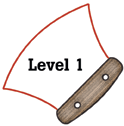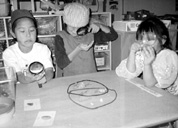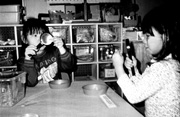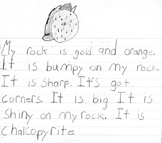 |
Mini-Unit:
Rock On
Performance Standard
B1, Level 1
Students observe and describe their world.
|
 |

Key Concepts and
Skills
|
- There are similarities and differences in nature.
- Measurement can be done in a variety of ways.
- Students can use the processes of science including observation,
classification, measurement, and prediction.
- Rocks come in many sizes and shapes.
|
 |

Timeline
|
This can take place over two or three weeks.
|
 |

Abstract
|
Students observe and measure rocks in order to classify and infer
usage from their characteristics.
|
 |

Materials
|
- Collection of rocks (local, purchased, or AMEREF Minerals Kit
)
- Assorted materials to use when designing tools
- Equal-arm balances
- Chart paper
- Markers
- Graph paper (1" squares)
- Yarn or hoops
- Small plastic bears, unifix or wooden cubes, tiles, etc.
- White paper
- Hand lens or magnifiers
|
 |

Activities
|
1
Teacher brings in a box of assorted rocks. Students play “20
Questions” about the contents of the box. After contents
are guessed, the rocks are distributed among students and they
observe the rocks using their eyes, hands, lenses or magnifiers.
Ask students such things as how are they alike, how are they different,
what words would you use to describe the rocks? Record responses
on chart paper for class to see. Place rocks in a science center
in the classroom.
2
 Teacher
has whole class gather around and places 16–20 assorted rocks
in a pile on a piece of paper. Have a student choose an attribute
such as small. Move all the small rocks into a pile, label it
small, and draw a circle around it. Place the other rocks in a
pile, draw a circle around it and label it not small. Keep dividing
the piles using properties (shiny, not shiny; rough, not rough;
heavy, not heavy) until you have used all the rocks you started
with. Give each student group (three to four students) 16–20
rocks. Ask them to create their own classification system. *This
is an example of binary classification. (*As students are grouping
their rocks, the teacher walks around with a checklist to assess
how students are doing with their classifying skills. Any type
of classification should be accepted as long as the student can
justify it.) Teacher
has whole class gather around and places 16–20 assorted rocks
in a pile on a piece of paper. Have a student choose an attribute
such as small. Move all the small rocks into a pile, label it
small, and draw a circle around it. Place the other rocks in a
pile, draw a circle around it and label it not small. Keep dividing
the piles using properties (shiny, not shiny; rough, not rough;
heavy, not heavy) until you have used all the rocks you started
with. Give each student group (three to four students) 16–20
rocks. Ask them to create their own classification system. *This
is an example of binary classification. (*As students are grouping
their rocks, the teacher walks around with a checklist to assess
how students are doing with their classifying skills. Any type
of classification should be accepted as long as the student can
justify it.)
3
 Ask
a student to choose 10 rocks that have several attributes and
bring them from the science center to a place that has a Venn
diagram set up (a Venn diagram can be created by using yarn or
plastic hoops). Students gather around and together they will
choose two rules to sort the rocks (like big and jagged). Write
the rules on a folded piece of paper that can be placed in the
circles. Students decide where to place the 10 rocks according
to the rules. Ask students what they notice about the rocks in
each circle. Guide them if necessary to the conclusion that some
rocks fit both of the rules and should be placed in both circles.
Ask how a rock could be in both circles at the same time. If students
do not come up with moving the circles, begin to overlap them.
Spend some time asking questions that lead to student understanding
of the “intersection” of both circles. When students
have an understanding, ask them to place the rocks according to
the chosen rules. Repeat this again and again choosing different
attributes to use in sorting. (This is another opportunity for
teachers to do a short check to find out at what level students
can use a Venn diagram.) Ask
a student to choose 10 rocks that have several attributes and
bring them from the science center to a place that has a Venn
diagram set up (a Venn diagram can be created by using yarn or
plastic hoops). Students gather around and together they will
choose two rules to sort the rocks (like big and jagged). Write
the rules on a folded piece of paper that can be placed in the
circles. Students decide where to place the 10 rocks according
to the rules. Ask students what they notice about the rocks in
each circle. Guide them if necessary to the conclusion that some
rocks fit both of the rules and should be placed in both circles.
Ask how a rock could be in both circles at the same time. If students
do not come up with moving the circles, begin to overlap them.
Spend some time asking questions that lead to student understanding
of the “intersection” of both circles. When students
have an understanding, ask them to place the rocks according to
the chosen rules. Repeat this again and again choosing different
attributes to use in sorting. (This is another opportunity for
teachers to do a short check to find out at what level students
can use a Venn diagram.)
4
Students will look at specific attributes of rocks and use them
to sequence the rocks (e.g., lightest to darkest; smallest to
largest). Students begin with three rocks and then work up to
using five rocks. Students use a gold dredge worksheet like the
one below to draw their rock sequence.
5
Give students graph paper with at least one-inch squares. Tell
them to choose a rock and place it on the paper. Ask students
how many squares big their rock is. Students choose three more
rocks to repeat the procedure.
6
 Choose
two or three students to come up in front of the class and hold
two different size rocks. Ask which rock is heavier? How they
can tell? Ask the students if they know of other ways to measure
how much things weigh. (Hopefully they will come up with using
balances). Provide students with an equal-arm balance and cubes,
bears, tiles, etc., that they can measure. Students will weigh
three to five different items and record their findings. Choose
two or three students to come up in front of the class and hold
two different size rocks. Ask which rock is heavier? How they
can tell? Ask the students if they know of other ways to measure
how much things weigh. (Hopefully they will come up with using
balances). Provide students with an equal-arm balance and cubes,
bears, tiles, etc., that they can measure. Students will weigh
three to five different items and record their findings.
7
Brainstorm ways that rocks could be used by people and animals.
Chart the ideas given by the students. Invite community people
to come into the classroom to discuss traditional uses of rocks
(e.g., communication, tools, fishing, hunting, etc.). Using their
knowledge of rock characteristics, students investigate and design
a tool using a rock. Display student work.
|
 |

Expanded Sample
Assessment Idea
|
Procedure
Students will:
- Collect rocks at home and school.
- Divide into groups of two to three; take a group of 8–12
rocks and classify them by criteria of their group’s choosing.
This could include color, size, shape, texture, use, and so
on. Groups will share with each other the ways they classified
the rocks. Each group will then go back and create a different
way to classify their rocks. Each group should guess the other
group’s new classification.
- Draw how their group classified a rock of their choice and
include details like color, shape, and size.
- Discuss volunteers’ pictures in circle group.
Reflection and Revision
Use comments about pictures and redraw their rock classification.
Level of Performance
|
|
|
Student work is correct, complete and appropriate.
Student work includes detailed explanations of their two classification
systems, and are detailed. There is no evidence of misconceptions
or inaccurate descriptions; drawings have accurate colors and realistic
size. |
|
|
Student work is generally correct, complete, and appropriate
including two classification systems of rocks. Student explanations
of classification systems are accurate. Drawings may show a few inaccuracies
or unrealistic descriptions of the actual rocks. |
Stage 2


|
Student classifications are mostly appropriate, but
there may be some misconceptions. Student could not explain classifications.
Drawings are incomplete. There is little evidence of elaboration or
extensions. |
Stage 1

|
Student did not complete classifications and could not tell why.
No drawings completed. There is no evidence of elaboration or extensions.
There is evidence of misconceptions.
|
 |

Standards Cross-Reference
(Alaska
Department of Education & Early Development Standards)
|
 National
Science Education Standards National
Science Education Standards
Employ simple equipment and tools to gather data and extend
the senses. In early years, students develop simple skills, such
as how to observe, measure, cut, connect, switch, turn on and
off, pour, hold, tie, and hook. Beginning with simple instruments,
students can use rulers to measure the length, height, and depth
of objects and materials; thermometers to measure temperature;
watches to measure time; beam balances and spring scales to measure
weight and force; magnifiers to observe objects and organisms;
and microscopes to observe the finer details of plants, animals,
rocks, and other materials. Children also develop skills in the
use of computers and calculators for conducting investigations.
(Page 122)
Use data to construct a reasonable explanation. This aspect
of the standard emphasizes the students’ thinking as they
use data to formulate explanations. Even at the earliest grade
levels, students should learn what constitutes evidence and judge
the merits or strength of the data and information that will be
used to make explanations. After students propose an explanation,
they will appeal to the knowledge and evidence they obtained to
support their explanations. Students should check their explanations
against scientific knowledge, experiences, and observations of
others. (Page 122)
 Communicate
investigations and explanations. Students should begin developing
the abilities to communicate, critique, and analyze their work
and the work of other students. This communication might be spoken
or drawn as well as written. (Page 122) Communicate
investigations and explanations. Students should begin developing
the abilities to communicate, critique, and analyze their work
and the work of other students. This communication might be spoken
or drawn as well as written. (Page 122)
Simple instruments such as magnifiers, thermometers, and rulers
provide more information than scientists obtain using only their
senses. (Page 123)
Scientists develop explanations using observations (evidence)
and what they already know about the world (scientific knowledge).
Good explanations are based on evidence from investigations. (Page
123)
Benchmarks
People can often learn about things around them by just observing
those things carefully, but sometimes they can learn more by doing
something to the things and noting what happens. (Page 10)
Tools such as thermometers, magnifiers, rulers, or balances
often give more information about things than can be obtained
just by observing things without their help. (Page 10)
Describing things as accurately as possible is important in
science because it enables people to compare their observations
with those of others. (Page 10)
Ask “How do you know?” in appropriate situations and
attempt reasonable answers when others ask them the same question.
(Page 298)
|
|
|
Alaska Science Content
Standard Key Element
A
student who meets the content standard should use the processes of science;
these processes include observing, classifying, measuring, interpreting
data, inferring, communicating, controlling variables, developing models
and theories, hypothesizing, predicting, and experimenting.
Cross-Reference
Additional
Content and Performance Standards: A7, Geography E1, Math A2, E2, E3.
Cultural Standards: D1, D5
|





 Teacher
has whole class gather around and places 16–20 assorted rocks
in a pile on a piece of paper. Have a student choose an attribute
such as small. Move all the small rocks into a pile, label it
small, and draw a circle around it. Place the other rocks in a
pile, draw a circle around it and label it not small. Keep dividing
the piles using properties (shiny, not shiny; rough, not rough;
heavy, not heavy) until you have used all the rocks you started
with. Give each student group (three to four students) 16–20
rocks. Ask them to create their own classification system. *This
is an example of binary classification. (*As students are grouping
their rocks, the teacher walks around with a checklist to assess
how students are doing with their classifying skills. Any type
of classification should be accepted as long as the student can
justify it.)
Teacher
has whole class gather around and places 16–20 assorted rocks
in a pile on a piece of paper. Have a student choose an attribute
such as small. Move all the small rocks into a pile, label it
small, and draw a circle around it. Place the other rocks in a
pile, draw a circle around it and label it not small. Keep dividing
the piles using properties (shiny, not shiny; rough, not rough;
heavy, not heavy) until you have used all the rocks you started
with. Give each student group (three to four students) 16–20
rocks. Ask them to create their own classification system. *This
is an example of binary classification. (*As students are grouping
their rocks, the teacher walks around with a checklist to assess
how students are doing with their classifying skills. Any type
of classification should be accepted as long as the student can
justify it.)
 Ask
a student to choose 10 rocks that have several attributes and
bring them from the science center to a place that has a Venn
diagram set up (a Venn diagram can be created by using yarn or
plastic hoops). Students gather around and together they will
choose two rules to sort the rocks (like big and jagged). Write
the rules on a folded piece of paper that can be placed in the
circles. Students decide where to place the 10 rocks according
to the rules. Ask students what they notice about the rocks in
each circle. Guide them if necessary to the conclusion that some
rocks fit both of the rules and should be placed in both circles.
Ask how a rock could be in both circles at the same time. If students
do not come up with moving the circles, begin to overlap them.
Spend some time asking questions that lead to student understanding
of the “intersection” of both circles. When students
have an understanding, ask them to place the rocks according to
the chosen rules. Repeat this again and again choosing different
attributes to use in sorting. (This is another opportunity for
teachers to do a short check to find out at what level students
can use a Venn diagram.)
Ask
a student to choose 10 rocks that have several attributes and
bring them from the science center to a place that has a Venn
diagram set up (a Venn diagram can be created by using yarn or
plastic hoops). Students gather around and together they will
choose two rules to sort the rocks (like big and jagged). Write
the rules on a folded piece of paper that can be placed in the
circles. Students decide where to place the 10 rocks according
to the rules. Ask students what they notice about the rocks in
each circle. Guide them if necessary to the conclusion that some
rocks fit both of the rules and should be placed in both circles.
Ask how a rock could be in both circles at the same time. If students
do not come up with moving the circles, begin to overlap them.
Spend some time asking questions that lead to student understanding
of the “intersection” of both circles. When students
have an understanding, ask them to place the rocks according to
the chosen rules. Repeat this again and again choosing different
attributes to use in sorting. (This is another opportunity for
teachers to do a short check to find out at what level students
can use a Venn diagram.)
 Choose
two or three students to come up in front of the class and hold
two different size rocks. Ask which rock is heavier? How they
can tell? Ask the students if they know of other ways to measure
how much things weigh. (Hopefully they will come up with using
balances). Provide students with an equal-arm balance and cubes,
bears, tiles, etc., that they can measure. Students will weigh
three to five different items and record their findings.
Choose
two or three students to come up in front of the class and hold
two different size rocks. Ask which rock is heavier? How they
can tell? Ask the students if they know of other ways to measure
how much things weigh. (Hopefully they will come up with using
balances). Provide students with an equal-arm balance and cubes,
bears, tiles, etc., that they can measure. Students will weigh
three to five different items and record their findings.
 National
Science Education Standards
National
Science Education Standards Communicate
investigations and explanations. Students should begin developing
the abilities to communicate, critique, and analyze their work
and the work of other students. This communication might be spoken
or drawn as well as written. (Page 122)
Communicate
investigations and explanations. Students should begin developing
the abilities to communicate, critique, and analyze their work
and the work of other students. This communication might be spoken
or drawn as well as written. (Page 122)